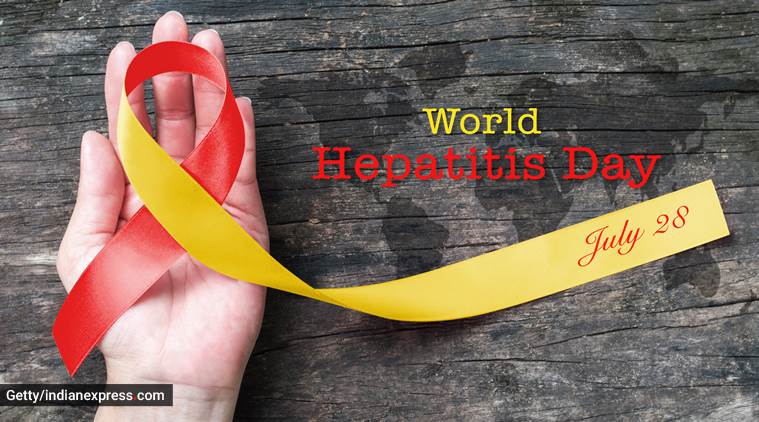
Many people mistakenly think that hepatitis means viral hepatitis, and that all forms of hepatitis are contagious. Actually, the word hepatitis refers to any inflammation of the liver – the irritation or swelling of the liver cells from any cause

Nearly 1.3 million deaths occur annually due to viral hepatitis worldwide, with 300 million people living with the disease, unaware of their infection status. In 2016, WHO launched the campaign “Eliminate Hepatitis by 2030”. In 2020, on World Hepatitis Day(July 28), the theme is “Find the Missing Millions”. Screening and early detection are the only ways to tackle this silent killer, since liver damage in chronic viral hepatitis progresses without symptoms till it reaches the terminal illness stage, as either liver cancer or liver cirrhosis. Vaccination is, however, available for Hepatitis A and B viruses.
What is hepatitis?
Many people mistakenly think hepatitis means viral hepatitis, and that all forms of hepatitis are contagious. Actually, the word hepatitis refers to any inflammation of the liver — the irritation or swelling of the liver cells from any cause. Hepatitis can be acute (inflammation of the liver that presents with sickness — jaundice, fever, vomiting) or chronic (inflammation of the liver that lasts more than six months, but essentially asymptomatic) and has many different causes.
It is usually caused by a group of viruses known as the “hepatotropic” (liver directed) viruses, including A, B, C, D and E. Other viruses may also cause it, such as those that cause mononucleosis (the Epstein-Barr virus) or chicken pox (the varicella virus). Hepatitis also refers to inflammation of the liver caused by drugs and alcohol abuse or toxins in the environment. In addition, people can develop hepatitis from other causes such as fat buildup in the liver called “fatty liver hepatitis” or NASH (Nonalcoholic steatohepatitis) or an autoimmune process in which a person’s body makes antibodies that attack the liver (autoimmune hepatitis).
ALSO READ | Simple tips to protect yourself from Hepatitis E this monsoon
Viral hepatitis is common. Most people with chronic hepatitis are not diagnosed since it is largely silent and asymptomatic and many people mistake their symptoms for flu. The five hepatitis viruses can be transmitted in different ways, but they all have one thing in common: they infect the liver and make it swell up. Many people with acute hepatitis recover with a lifelong immunity to the disease, but some people with hepatitis die in the acute phase (fulminant liver failure). Hepatitis B and C may progress to chronic hepatitis, in which the liver remains inflamed for a decade or more. This can lead to cirrhosis and liver cancer.
What are the different hepatitis viruses?

There are five main hepatitis viruses, referred to as types A, B, C, D and E. In particular, types B and C lead to chronic disease in millions of people world over and together, are the most common cause of liver cirrhosis and cancer. Hepatitis A and E are typically caused by ingestion of contaminated food and water. Hepatitis B, C and D usually occur through contact with infected blood and body fluids. Common modes of transmission for these viruses include receipt of contaminated blood and blood products, invasive medical and non-medical procedures using contaminated equipment, transmission from mother to baby at birth and also by sexual contact. Acute infection may occur with limited or no symptoms, or may include symptoms such as jaundice (yellowing of the skin and eyes), dark urine, fever, fatigue, nausea, vomiting and abdominal pain. In addition to these hepatotropic viruses, many other less common viruses like Varicella, Herpes simplex, Cytomegalovirus, etc., which are not specifically targeting the liver, may injure the liver. Notably, SARSCOV2, the virus causing COVID 19 may injure the liver, too.
Hepatitis A virus (HAV) is present in the feces of infected persons and is most often transmitted through consumption of contaminated water or food. Infections are in many cases mild, with most people making a full recovery and remaining immune from further HAV infections lifelong. This infection, however, can also be severe and life threatening. Most people in areas of the world with poor sanitation including rural India get infected with this virus. Safe and effective vaccines are available for its prevention.
Hepatitis B virus (HBV) is transmitted through exposure to infective blood and other body fluids. HBV can be transmitted from infected mothers to infants at the time of birth. Transmission may also occur through transfusion of HBV – contaminated blood and blood products, through injections during medical procedures and through injection drug use. HBV also poses a risk to healthcare workers (doctors, nurses) who sustain accidental needle stick injuries while caring for infected – HBV patients. Safe and effective vaccines are available to prevent HBV.
ALSO READ | Acute liver failure: All you need to know
Hepatitis C virus (HCV) is mostly transmitted through exposure to infective blood. This may happen through transfusion of HCV – contaminated blood and products, contaminated injections during medical procedures, and through injection drug use. Sexual transfusion is also possible, but is much less common. Intravenous Drug Abuse (IVDU) is an evolving cause of HCV transmission in India. There is no vaccine for HCV.
Hepatitis D virus (HDV) infections occur only in those who are infected with HBV. The dual infection of HDV and HBV can result in a more serious disease and worse outcome. Hepatitis B vaccines provide protection from HDV infection.
Hepatitis E virus (HEV) is mostly transmitted through consumption of contaminated water or food. HEV is a common cause of hepatitis outbreaks in developing parts of the world and is increasingly recognised as an important cause of disease in developed countries. In India, it is more common in north India, especially Jammu and Kashmir.
COVID 19 Hepatitis: SARSCOV2 which causes COVID-19 is not a liver tropic virus. In severe cases of COVID-19, the liver may get involved. An important point to be noted here is that liver injury in SARSCOV is by various mechanisms though, from direct infection of the liver cells and biliary cells to the liver getting caught up in the immune war between the virus and body’s immune system. Body produces certain chemicals called cytokines to thwart the virus, but the same may induce injury to the liver as well. Many medications are being given in COVID in various countries, some of these may induce liver injury. Even pressure from mechanical ventilation from the lung can cause congestion in the liver and throw LFTs in the abnormal range. All said and done, liver involvement in COVID-19 is mostly seen in severe cases and it reverses when patient recovers from COVID-19.
What are the symptoms and signs of acute viral hepatitis?

The period between viral entry into the body to hepatitis and the onset of illness is called the “incubation period”. It varies from virus to virus. Hepatitis A and E viruses have an incubation period of about two to six weeks while Hepatitis B and C roughly have an incubation period of two to six months. Symptoms of acute viral hepatitis include flu like symptoms, fatigue, dark urine, fever, vomiting and jaundice (yellow discoloration of skin and the eyes). However, infection with these viruses may occur with minimal symptoms or even may go unnoticed. Rarely, acute viral hepatitis can end up in a very severe form called “fulminant liver failure” (drastic decline of liver function in a short span of hours to days resulting in death). Treatment of acute fulminant hepatitis should be done in centres that can perform liver transplantation, since fulminant hepatitis has high death rate to the tune of 80 per cent without liver transplantation.
What is chronic hepatitis?
In contrast to waterborne viruses, while the viruses transmitted through blood and body fluids (Hepatitis B, C) can have an acute presentation as mentioned above, more commonly they remain silently in the body for a decade or two and cause chronic hepatitis. Chronic hepatitis literally means longstanding hepatitis. The immune system is unable to eradicate B and C viruses and hence these viruses cause unrelenting long-drawn silent inflammation (Chronic Hepatitis) and scarring (Fibrosis) in the liver, lasting for many years. These processes ultimately result in cirrhosis and liver cancer. The patient is essentially without any symptoms when silent damage happens in chronic hepatitis. Early detection at the silent curable stage rarely happens. Biggest barrier to achieve successful treatment is the fact that curable stage of chronic viral hepatitis is the silent phase, but disease mostly gets diagnosed when patients have symptoms which most of the time is advanced and incurable stage. Lucky are those in whom incidental detection of chronic hepatitis due to C and B viruses happen when one attempts to donate blood or during medical checkup for visa processing for jobs abroad.
Serious consequences of chronic hepatitis B and C
Major health consequences of chronic hepatitis due to HBV and HCV are development of cirrhosis and liver cancer. It takes a decade and more after entry of the virus into the body to evolve into these lethal complications, which means a wide window of opportunity is present to treat and clear the virus, provided the infection is detected early. Since long standing hepatitis (chronic hepatitis) due to HBV and HCV induce damage silently, successful treatment depends on identifying the infection by doing screening tests. Since there is risk of liver cancer in HBV and HCV infection, regular follow-up with a liver specialist to identify cancerous lesion at an early stage.
ALSO READ | World Hepatitis Day: Common Hepatitis myths debunked
Is treatment available?
HAV and HEV are self-limiting diseases and require no specific antiviral medications. Only supportive care and careful monitoring is all that is needed. There are effective medications available to treat HBV and HCV. Treatment can help to protect you from serious liver damage. Effective medications are available for both HCV and HBV in the injectable form as well as tablets. The conventional one-year-long injectable medicines for HCV has been replaced by oral medications and duration of treatment shortened to just 12 weeks. Early diagnosis is crucial because the sooner treatment is started, further liver damage can be arrested. Treatment can also help to lessen damage to the liver and can prevent you from spreading the virus to others unknowingly.
Is there a role for surgery in the treatment of viral hepatitis?
In longstanding viral hepatitis due to HBV and HCV, scar formation takes place and ultimately may end up in liver cirrhosis. When liver cirrhosis leads on to failure of liver functions and increased pressure inside the liver, these might necessitate liver transplant intervention. Also, scarred liver forms a background for liver cancer formation. Select cancers can be dealt with by resecting the portion of liver affected by cancer.
Screening and early detection
Screening and early detection are key to successful eradication of these viruses before irreversible damage sets in. Without finding out the undiagnosed patients in silent phase and link them to care, millions will continue to suffer and lives will be lost. In 2016, 194 governments across the globe adopted WHO’s global strategy which aims at eliminating viral hepatitis by 2030.Only few countries have put in concerted efforts to reach this time bound target. On July 28, World Hepatitis Day focuses on raising awareness and the quest to find missing millions through screening programmes.

Lifestyle measures and precautions to prevent liver damage due to viral hepatitis
(The author is a senior consultant hepatologist and liver transplant physician, Global Hospital, Chennai; Kinder Multispecialty Hospital, Kochi)
? The Indian Express is now on Telegram. Click here to join our channel (@indianexpress) and stay updated with the latest headlines
For all the latest Lifestyle News, download Indian Express App.
Source: Read Full Article


